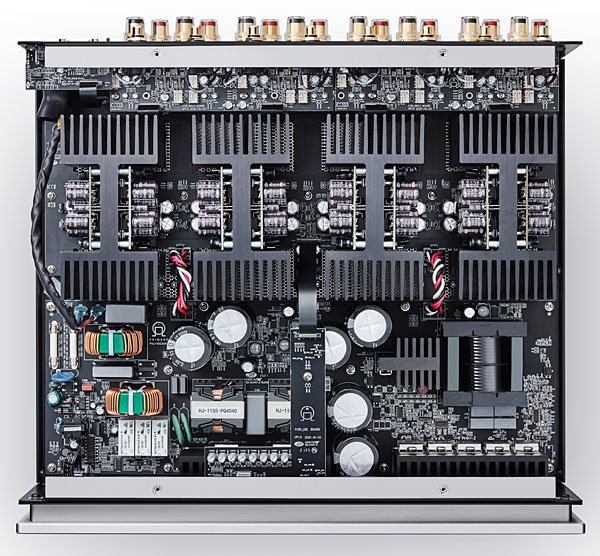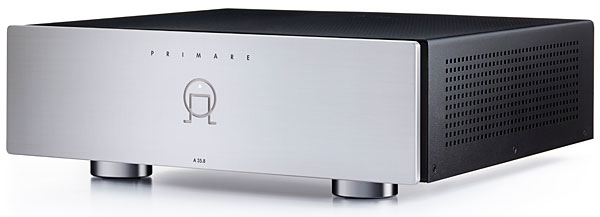Primare A35.8 Eight-Channel Power Amplifier Review Page 2
Performance
That's a lot of build-up for what is in its essence a very short report: Primare's A35.8 is a fully transparent, totally competent, and, depending on the load and configuration, immensely powerful amplifier. Regular readers may recall that I ascribe nearly all reports of power amplifier "sound" to either inferior design—usually input or output impedances that induce substantial frequency-response errors from component interactions—or to subtle (or not-so-subtle) non-linearities that occur when an amplifier reaches its limits or is approaching its limits when "protection" circuits kick in. (Of course, some amp "sounds" surely fall to pure subjectivity. And then there's the host of amplifier designs, often tube-based, that don't attempt modern-design transparency at all, but strive for euphonic variation—I hesitate to use the word "distortion." But that's a whole 'nuther rant.)

So, unsurprising to me, during its unbridged two-channel workout, the Primare sounded indistinguishable from my everyday amp, a conventional class-A/B design that's about 6 years old and also rated to deliver 150 watts into 8 ohms. On even the most demanding program material, the amp effortlessly drove my Energy 2.2 speakers to their useful limits, filling my room with sparkling, dynamic sound. Did the Primare have an edge in top-volume clarity and punch? I think so, but such evaluations are tricky. First, because A-B comparisons are impractical, and second, because as we plumb the upper potential of most amplifiers we are also probing the nexus of loudspeaker limits (although despite their age, the Energy 2.2's can absorb prodigious amounts of clean power) and what I think of as hearing overload (where the ear-brain system — mine, anyway — rebels at unnatural loudness with distortions of its own).
When I rewired the A35.8 for a bridged workout and created two channels out of four, I can't say I detected any change. With nearly three times the power potential, the Primare amp wasn't working as hard but, then again, its unbridged abilities were already more than sufficient for my needs.
Next, I reconfigured the amp in its four-channel, bridged mode, creating individual channels spec'd to deliver 740 watts into 8 ohms. After a brief invocation—offering up 700-plus watts to the Energy's 1-inch tweeter/2-inch midrange combo is not to be taken lightly since I can't exactly pick up replacements at RadioShack—I set up each speaker for bi-amp operation and removed the jumpers between its low- and high-pass-inputs, allowing one amp channel to drive the mid/tweeter array and the other the woofer. I crossed my fingers and fired up one of the most dynamic recordings I know—the Sheffield Drum Record—and listened while my aging Energy 2.2's explored their ultimate potential.
The sound was electrically charged as I gingerly probed drums playing at lifelike volumes. And when I turned to a long-favored SACD of Mahler's first symphony, selecting the two-channel layer I usually skip over, I reveled in the magisterial sound of dynamically unrestricted orchestral reproduction. The sound was comparable with—though perhaps incrementally better than—what I heard during the previous bridged expedition.

But was all this power overkill? Well, an orchestra playing late romantic-era music can crest 110dB SPL (sound-pressure level) on stage and get close to 100dB at the front row. With speakers like my Energys in the sub-85dB/1-meter sensitivity range, and with a listening distance of more than 3 meters, the math suggests, "not by all that much." Having 12dB or so of headroom above 20dBw (100 watts) is generous but not unreasonable. Whatever the case, the Energys never sounded better playing in two-channel. (And I didn't blow anything up!)
For the final act, I shifted to surround sound and connected eight unbridged channels to my everyday pre-pro using unbalanced RCA connections. The A35.8 breezed through The Black Keys' multichannel-music romp "It Ain't Over" (streamed in Dolby Atmos over Tidal), propelling the bass and drums with delightful impact and arching the dense choruses up, over, and around without so much as breaking a sweat.
The same was true for movies. I watched a selection of favorite scenes at THX theatrical (loud!) levels, and streamed the full length of Dune (2021) over HBO-Max with praiseworthy results: there was never a hint of any power shortfall with the system playing without a subwoofer in my 3,000-cubic-foot room. Even more impressive was the "rain" clip from the original Dolby Atmos Blu-ray demo disc with its 360-degree presentation of mostly soft wind and rain, punctuated by distant thunder, which rolled believably across all nine channels (only eight of which the Primare gets credit for, of course). Again, my system never sounded so good.
One final observation: The A35.8's signal-to-noise performance (and thus real-world dynamic range) is superb. With the program paused with both balanced and unbalanced connections, I walked around the room pressing my ear to the tweeter (or midrange driver) and heard only the barest of whispers from the midrange and, even then, it was only discernible from a distance of a half inch or less. It's also worth noting that I never once saw any of the A35.8's eight clipping indicators (which blink through the cooling grilles in the top cover) light up in any mode.
Conclusion
There are many uses for power, and in my months with the A35.8, I explored most of them. At no point did Primare's eight-channel design fall short in quantity or quality of amplification, making "bigger without change" and without complaint, no matter what I sent its way. That earns the A35.8 a straight "A" in my book (for an "A+," they need to add that ninth channel). Yes, it's expensive, but you can spend two or even four times as much per channel and, at least in my opinion, gain nothing—except bragging rights.


























































